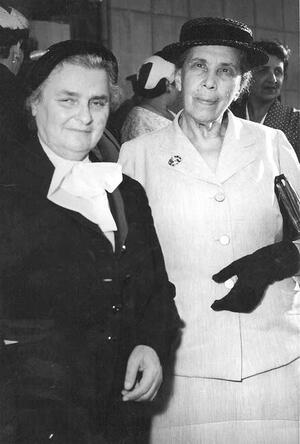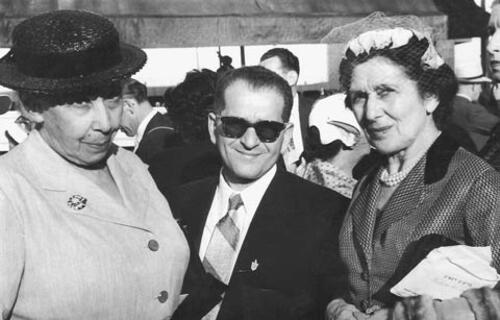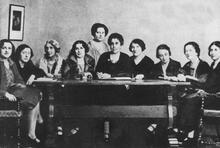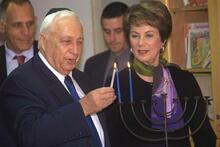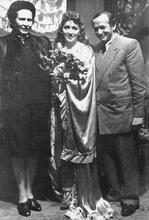Helena Kagan
Courtesy of WIZO Archives, Tel Aviv.
Helena Kagan, a pioneer of pediatric medicine in pre-State Palestine, is known to this day as the children’s doctor of Jerusalem, the city where she settled following her aliyah in 1914. Kagan tended to generations of children—Jews, Muslims, and Christians—saving many of them from sickness and death. She devoted her life to improving welfare services and living conditions. Children’s health, love of Jerusalem, and the hope for peace between Jews and Arabs were the three central themes of her life. Kagan founded the first Jewish children’s hospital in Palestine, created childcare centers, and helped found a local chapter of WIZO, among other accomplishments. She received numerous awards throughout her life, including the Israel Prize and the title of Honorary Citizen of Jerusalem.
Helena Kagan, a pioneer of pediatric medicine in pre-State Palestine, is known to this day as the children’s doctor of Jerusalem, the city where she settled following her Lit. "ascent." A "calling up" to the Torah during its reading in the synagogue.aliyah in 1914. Kagan tended to generations of children—Jews, Muslims and Christians—saving many of them from sickness and death. She devoted her life to improving welfare services and living conditions. In her memoirs, she wrote: “Throughout my career, I tried to uphold my two great loves: the love of children and the love of Jerusalem. I sought to instill in the Arab residents the sense that we—the Jews returning to our homeland—are sincerely interested in peace and friendly relations with all residents of the Holy City.”
In an interview conducted towards the end of her life, she stated: “The thought that I have lived a long life and succeeded in bringing health to generations of children is what gives me the strength to keep on hoping that I will be privileged to witness the peace that we so long for.” Children’s health, love of Jerusalem and the hope for peace between Jews and Arabs were the three central themes of her life.
Early Life and Education
Kagan was born on September 25, 1889, in Tashkent, capital of Turkestan (later Uzbekistan) in Russia. Her family consisted of her mother Miriam, a native of Riga; her father Moshe (d. 1912), from Latvia; and a brother, Noah (b. 1885). Kagan’s father, a descendant of the famed Vilna Head of the Torah academies of Sura and Pumbedita in 6th to 11th c. Babylonia.Gaon, studied in yeshiva in Warsaw and at the Institute of Technology in St. Petersburg. As a chemical engineer, he was sent to establish and supervise the construction of glass-manufacturing plants in Tashkent; there, Kagan was born, grew up, and completed her studies. In early 1905, Noah left Russia to study medicine in Breslau, Germany, while Kagan traveled to Switzerland to study piano at the Bern Conservatory. At the same time, she commenced premedical studies as an external student, but it was only two years later that she received permission to be examined on the course material. Her success in the examinations paved the way for her to enter the medical school as a regular student.
In 1910, she completed her basic medical studies, going on to specialize in pediatrics. Upon completing her studies, Kagan accepted an offer to join the research staff of the Medical Faculty’s Department of Physiology, but first she traveled to Russia to see her family. Her father, who lay on his deathbed, implored his children to go to Palestine, so that they might see with their own eyes “the land the Jewish people lost but have never forgotten.”
Early Medical Practice
Kagan carried out her father’s dying wish, and on April 29, 1914, she and her mother set foot “on the soil of the Holy Land.” After a brief stay in Tel Aviv, Kagan moved to Jerusalem, where she was henceforth to live and work. She moved into a stone house near the Meah She’arim neighborhood, set up a clinic and laboratory in one of its rooms, and waited for patients. To her disappointment, they were slow in coming: since she was only twenty-five, no one took seriously “this young woman who claimed to be a doctor.”
In the interim, World War I had broken out, and the Ottoman regime did not permit her to work in her profession. In order to manage financially, she rented out rooms in her home and from 1914 to 1916 worked as a nurse at the municipal hospital. In addition, Kagan trained Arab and Jewish girls aged fifteen to sixteen to serve as hospital nurses, and worked in tandem with two public health nurses sent by Hadassah in America to institute a regional visiting nurse program for mother and child care.
With the outbreak of the war the two Hadassah nurses left Palestine and Kagan continued to provide medical assistance from her home. To overcome the high rate of infant mortality resulting from malnutrition, she purchased a cow and preserved its milk in bottles placed in clay containers filled with water; this milk would be given to sick children who visited her clinic. Slowly but surely, Kagan’s work at the municipal hospital garnered respect, and she earned the trust of the Jewish and Arab communities alike despite the fact that she was a young, inexperienced female physician. The loving names bestowed on her—“savior-doctor,” “angel of salvation” and “wonder doctor”—testify to the deep admiration in which she was held.
First Jewish Children’s Hospital
In 1916, when Dr. Abraham Ticho, the renowned ophthalmologist, was expelled by the Turks, he authorized Kagan to make use of his ophthalmic hospital and its equipment to provide additional medical services. Kagan turned the site into the first Jewish children’s hospital in Jerusalem and indeed in all of Palestine. Toward the end of the war, the situation in Jerusalem worsened; starving children wandered the streets in search of food and many of them perished from hunger. Kagan cleared a room in the hospital, gathered abandoned children and created the first day-care center for working mothers in the country.
In June 1919, the children’s hospital was transferred to the Rothschild-Hadassah hospital, where it was fully integrated as the pediatrics department of the hospital. Kagan was appointed head of pediatrics and ran the department until 1925. She continued operating a private clinic in her home and set up WIZO’s well-baby clinics. In 1921, Hadassah had established a health center for mothers, infants and young children (Tipat Halav) in the Old City of Jerusalem, the first of its kind in the field of mother and child care in Palestine. Kagan was appointed pediatrician at the clinic, working there on a volunteer basis. She instructed pregnant women and mothers in the care of their children and strove to promote the concept of preventive medicine and the importance of teaching mothers proper hygiene and childcare practices amid the primitive and difficult living conditions of early twentieth-century Jerusalem. From then onward, she was active in founding other Tipat Halav clinics as well as a network of WIZO daycare centers. She also established WIZO’s Childcare Division, which she headed until 1966.
In 1924 Kagan set up a children’s home in the Sha’arei Hessed neighborhood of Jerusalem for orphaned and abandoned children and infants from impoverished neighborhoods, where they could receive shelter and devoted care. Kagan served as the institution’s medical director, guided by the belief that it is the infancy and preschool years that determine the future physical and emotional development of the child. In keeping with this approach, she began working in 1925 at the Infants Home for Arab Children in the Old City of Jerusalem, where she served as medical director until 1948, when Jews were barred from that section of the city. Throughout she was an active member of WIZO. In 1936 she established Bikur Holim Hospital’s pediatrics department, which she headed until 1975. Kagan also established a special rheumatic fever division, combining it with her pediatrics department. She later served as chairwoman of the Israel Medical Association’s medical advisory committee on rheumatic fever. In July 1965 she founded a residential facility for asthmatic children in conjunction with the WIZO Baby Home in Jerusalem.
During Israel’s War of Independence, when Jerusalem was under siege, Kagan was appointed director of the medical department of the Jewish community of Jerusalem, a position which she also filled on the Central Medical Council. Assigned the task of running all medical and sanitary services in the city, her work included tending to refugees from the Arab neighborhoods and people confined to bomb shelters. But the bulk of her energy was devoted to rescuing infants and she took babies from dangerous areas to stay at the WIZO Baby Home.
Community Work
Kagan was involved not only in medical activity but also in community work. In 1920 she was among the founders of the Histadrut Nashim Ivriot (Hebrew Women’s Organization), which became the local chapter of WIZO. The organization’s charter meeting was held in her home. She served as a member of World WIZO’s board of directors from its inception and was a lifetime honorary member of World WIZO. In 1921 she represented the Palestine chapter at the first World WIZO Conference in Carlsbad, where she delivered a lecture on living conditions in Palestine and the desperate need for assistance. She also spoke of the high rate of infant mortality and the necessity of establishing an organization for preventive services to children. In 1931 Kagan was elected to the (pre-State) Asefat ha-Nivharim(Elected Assembly) of Keneset Yisrael (the Jewish Community) as WIZO’s representative. She also served on the Va’ad Leumi (National Council) for fourteen years, representing women. In 1937 she was appointed a member of the board of the Association of Friends of the Hebrew University in Jerusalem. In 1947 she was elected to the Executive of the Nominations Committee and the Board of Trustees of Hebrew University and in 1965 she became vice-chairwoman of the Board. Kagan was active in the Palestine-Jerusalem Pediatric Association, serving as its chairwoman from 1926 to 1943, in 1951 and in 1958. She also chaired the Health Ministry’s Advisory Committee on Child Welfare from 1953 to 1956.
Recognition and Legacy
Kagan became a legend in her own time, receiving numerous awards. In 1958 she was granted the title of Honorary Citizen of Jerusalem in recognition of her unique contribution to society and the community in the field of communal activity. This was followed in 1963 by an award from the La Rabida Hospital for Rheumatic Diseases of the University of Chicago for her contribution to research on rheumatic fever and in 1967, at an historic ceremony on Mt. Scopus, by an honorary doctorate from the Hebrew University, together with then-Chief of General Staff Yitzhak Rabin and President of Israel Zalman Shazar. In 1975, in honor of International Women’s Year, she was awarded the Israel Prize for her service to the community.
Kagan broke new ground in the fight against rheumatic fever, malnutrition and asthma in children. She published studies on rheumatic fever and infant anemia and participated in international conferences on pediatric medicine that brought her world renown in the field.
As a token of appreciation for Kagan’s work in caring for disadvantaged adolescents in Jerusalem’s poorer neighborhoods, British WIZO (Federation of Women Zionists) established the Helena Kagan Community Center in the deprived Katamon Tet quarter to mark her eightieth birthday. In keeping with her belief that juvenile delinquency can be prevented through education and direction, Kagan expressed her desire that the Center provide not only rehabilitative and social services for adolescents but also advice and guidance in solving problems within their families.
In her later years Kagan continued to treat patients in her home and to engage in communal work. In her memoirs, entitled The Voice That Called (1978) and in Hebrew Reshit Darki bi-Yerushalayim (1982), she writes: “For me, there is nothing greater in life than to see children and young people healthy and full of life, learning and working in a beautiful, flourishing Jerusalem.” The work is an important historical resource for the study of life in Palestine in the late Ottoman and early Mandatory periods.
In 1936 Kagan married Emil Hauser (1893–1978), a gifted violinist who in 1933 founded the Palestine Conservatory of Music in Jerusalem, which he directed for many years and of which Kagan herself served as honorary secretary from 1938 to 1946. The couple’s home was a center of music and culture, serving as a gathering place for concerts and meetings with local and international Zionist leaders.
Helena Kagan died childless on August 22, 1978, after a rich life filled with accomplishments.
Central Zionist Archives. Helena Kagan files, F49. Jerusalem, “A Review of Infant Welfare and Prenatal Work in Palestine, 1921–1926.” Hadassah Archives, RG/72/1. New York.
Kagan, Helena. The Voice That Called (Hebrew). Tel Aviv: 1982.
Shehory-Rubin, Zipora, and Shifra Shvarts. Hadassah for the Health of the People (Hebrew). Jerusalem: 2003, 119–120, 128, 131, 135.

